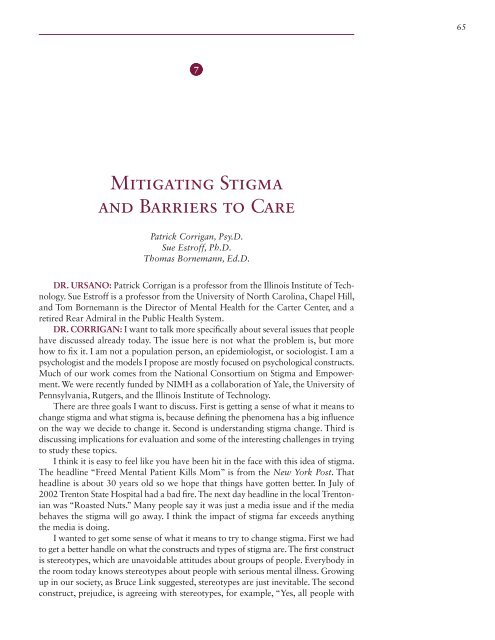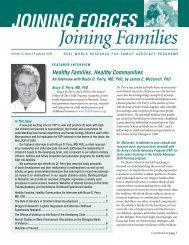stigma and barriers to care - Uniformed Services University of the ...
stigma and barriers to care - Uniformed Services University of the ...
stigma and barriers to care - Uniformed Services University of the ...
Create successful ePaper yourself
Turn your PDF publications into a flip-book with our unique Google optimized e-Paper software.
Mitigating Stigma <strong>and</strong> Barriers <strong>to</strong> Care 65<br />
7<br />
Mitigating Stigma<br />
<strong>and</strong> Barriers <strong>to</strong> Care<br />
Patrick Corrigan, Psy.D.<br />
Sue Estr<strong>of</strong>f, Ph.D.<br />
Thomas Bornemann, Ed.D.<br />
DR. URSANO: Patrick Corrigan is a pr<strong>of</strong>essor from <strong>the</strong> Illinois Institute <strong>of</strong> Technology.<br />
Sue Estr<strong>of</strong>f is a pr<strong>of</strong>essor from <strong>the</strong> <strong>University</strong> <strong>of</strong> North Carolina, Chapel Hill,<br />
<strong>and</strong> Tom Bornemann is <strong>the</strong> Direc<strong>to</strong>r <strong>of</strong> Mental Health for <strong>the</strong> Carter Center, <strong>and</strong> a<br />
retired Rear Admiral in <strong>the</strong> Public Health System.<br />
DR. CORRIGAN: I want <strong>to</strong> talk more specifically about several issues that people<br />
have discussed already <strong>to</strong>day. The issue here is not what <strong>the</strong> problem is, but more<br />
how <strong>to</strong> fix it. I am not a population person, an epidemiologist, or sociologist. I am a<br />
psychologist <strong>and</strong> <strong>the</strong> models I propose are mostly focused on psychological constructs.<br />
Much <strong>of</strong> our work comes from <strong>the</strong> National Consortium on Stigma <strong>and</strong> Empowerment.<br />
We were recently funded by NIMH as a collaboration <strong>of</strong> Yale, <strong>the</strong> <strong>University</strong> <strong>of</strong><br />
Pennsylvania, Rutgers, <strong>and</strong> <strong>the</strong> Illinois Institute <strong>of</strong> Technology.<br />
There are three goals I want <strong>to</strong> discuss. First is getting a sense <strong>of</strong> what it means <strong>to</strong><br />
change <strong>stigma</strong> <strong>and</strong> what <strong>stigma</strong> is, because defining <strong>the</strong> phenomena has a big influence<br />
on <strong>the</strong> way we decide <strong>to</strong> change it. Second is underst<strong>and</strong>ing <strong>stigma</strong> change. Third is<br />
discussing implications for evaluation <strong>and</strong> some <strong>of</strong> <strong>the</strong> interesting challenges in trying<br />
<strong>to</strong> study <strong>the</strong>se <strong>to</strong>pics.<br />
I think it is easy <strong>to</strong> feel like you have been hit in <strong>the</strong> face with this idea <strong>of</strong> <strong>stigma</strong>.<br />
The headline “Freed Mental Patient Kills Mom” is from <strong>the</strong> New York Post. That<br />
headline is about 30 years old so we hope that things have gotten better. In July <strong>of</strong><br />
2002 Tren<strong>to</strong>n State Hospital had a bad fire. The next day headline in <strong>the</strong> local Tren<strong>to</strong>nian<br />
was “Roasted Nuts.” Many people say it was just a media issue <strong>and</strong> if <strong>the</strong> media<br />
behaves <strong>the</strong> <strong>stigma</strong> will go away. I think <strong>the</strong> impact <strong>of</strong> <strong>stigma</strong> far exceeds anything<br />
<strong>the</strong> media is doing.<br />
I wanted <strong>to</strong> get some sense <strong>of</strong> what it means <strong>to</strong> try <strong>to</strong> change <strong>stigma</strong>. First we had<br />
<strong>to</strong> get a better h<strong>and</strong>le on what <strong>the</strong> constructs <strong>and</strong> types <strong>of</strong> <strong>stigma</strong> are. The first construct<br />
is stereotypes, which are unavoidable attitudes about groups <strong>of</strong> people. Everybody in<br />
<strong>the</strong> room <strong>to</strong>day knows stereotypes about people with serious mental illness. Growing<br />
up in our society, as Bruce Link suggested, stereotypes are just inevitable. The second<br />
construct, prejudice, is agreeing with stereotypes, for example, “Yes, all people with




